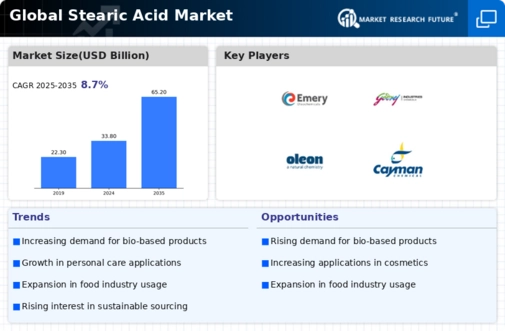Market Analysis
In-depth Analysis of Stearic Acid Market Industry Landscape
The stearic acid market is influenced by various dynamic factors that shape its growth and trends. Stearic acid, a saturated fatty acid derived from animal and vegetable fats, finds widespread application across industries such as cosmetics, pharmaceuticals, plastics, and rubber. One of the key market dynamics is the growing demand for stearic acid in the manufacturing of personal care and cosmetic products. As consumers become more conscious about the ingredients used in their skincare and cosmetic items, there has been a surge in the demand for natural and organic products, thereby driving the market for stearic acid derived from sources like palm oil and coconut oil.
Increasing use of stearic acid in the manufacturing of cosmetics products and soaps & detergents due to its function of lowering the surface tension is fuelling the product demand.
Another important factor impacting the market dynamics is the increasing adoption of stearic acid in the plastic and rubber industries. Stearic acid is used as a lubricant and release agent in the manufacturing process of various plastic and rubber products. With the growth of these industries, especially in emerging economies, the demand for stearic acid is expected to witness steady growth in the coming years.
Moreover, technological advancements and innovations in the production process of stearic acid have also contributed to the market dynamics. Manufacturers are constantly striving to enhance the efficiency and sustainability of their production processes to meet the evolving consumer preferences and regulatory requirements. This has led to the development of novel production methods and the introduction of eco-friendly alternatives, driving the market forward.
Furthermore, the regulatory landscape plays a crucial role in shaping the dynamics of the stearic acid market. Regulatory bodies around the world impose various restrictions and guidelines on the use of stearic acid in different industries, particularly in food and pharmaceuticals, to ensure product safety and quality. Compliance with these regulations requires manufacturers to invest in research and development activities, leading to changes in market dynamics.
Global economic conditions and geopolitical factors also influence the stearic acid market dynamics. Fluctuations in currency exchange rates, trade policies, and geopolitical tensions can impact the cost of raw materials, production, and distribution channels, thereby affecting the overall market dynamics. For instance, disruptions in the supply chain due to trade disputes or natural disasters can lead to temporary shortages or price fluctuations in the stearic acid market.
Moreover, the competitive landscape of the stearic acid market is characterized by the presence of several key players competing based on factors such as product quality, price, and innovation. Market dynamics are influenced by the strategies adopted by these players, including mergers and acquisitions, partnerships, and product launches. For example, strategic collaborations between stearic acid manufacturers and end-user industries can lead to the development of customized solutions and expansion of market reach, thereby impacting market dynamics.







Leave a Comment